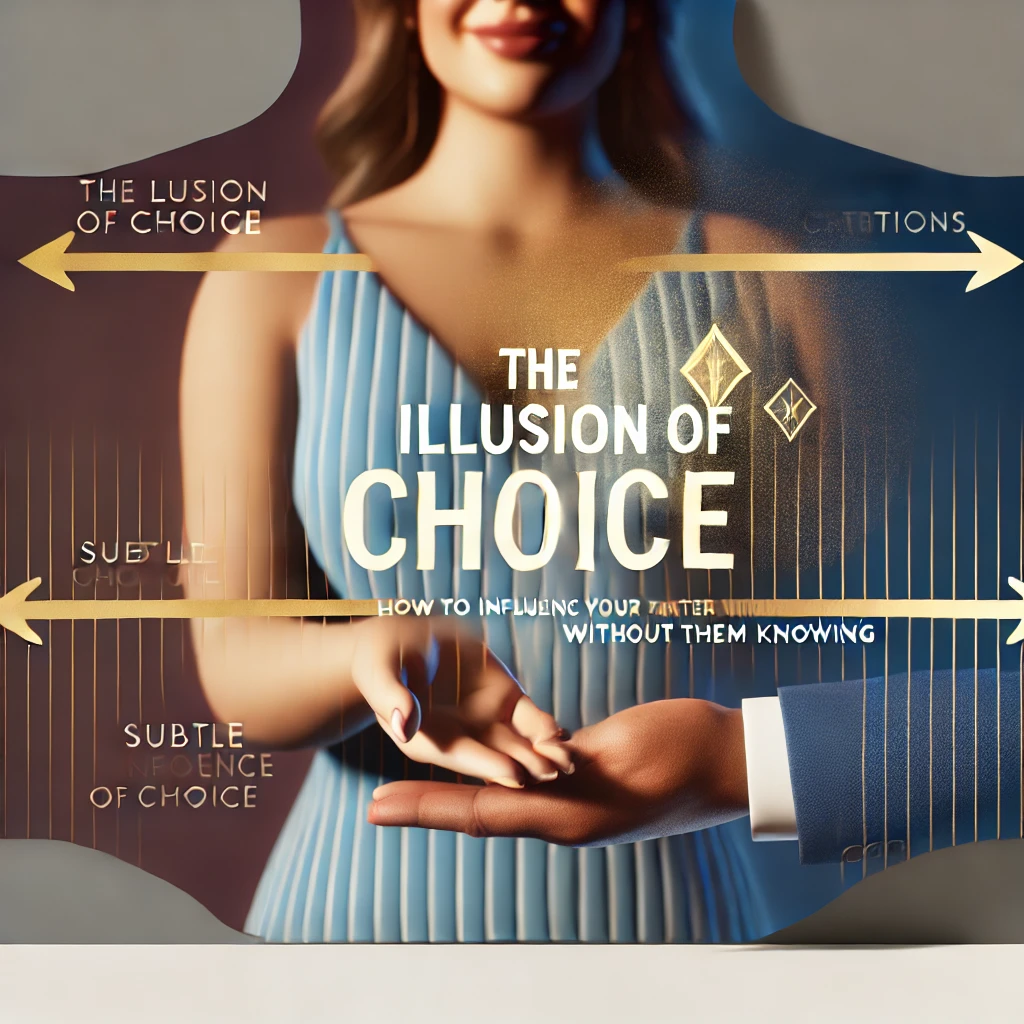When it comes to relationships, sometimes the key to getting what you want isn’t about making demands or ultimatums—it’s about creating the illusion of choice. The ability to influence your partner by making them feel in control, when in reality you’ve already steered the situation toward your desired outcome, is a powerful tool in any relationship. This tactic, known as The Illusion of Choice, gives your partner a sense of autonomy while gently guiding them to make decisions that align with what you want.
In this blog, we’ll explore how The Illusion of Choice works, why it’s so effective in relationships, and how you can use it to create a win-win dynamic. We’ll also dive into relatable, real-life examples to show how this technique can subtly influence your partner’s choices, all while making them feel empowered and respected. By the end of this, you’ll understand why this strategy can change the way you approach conversations, decisions, and even conflict resolution with your partner.
What Is The Illusion of Choice?
The Illusion of Choice is a psychological technique that gives your partner a set of options to choose from, all of which lead to the outcome you desire. The trick is that while they feel they’re making a decision, every option ultimately brings them to the same result—a result that benefits you both. It’s about framing the choices in a way that makes your partner feel empowered and involved in the decision-making process, even though you’ve structured the situation so that whichever option they choose, you get what you want.
For example, instead of asking your partner if they want to spend time with you tonight (which opens the door for a “no”), you give them two options that you’re happy with either way: “Would you rather watch a movie at home tonight or go out for dinner?” Both options involve spending time together, but by framing it as a choice, your partner feels like they have control over the decision.
Why Does The Illusion of Choice Work?
The Illusion of Choice works because it taps into a core psychological need for autonomy. People like to feel in control of their decisions. When someone feels like they’re being forced into a choice, they’re more likely to resist or push back. But when you offer them options, they feel empowered and are less likely to feel cornered or controlled.
In relationships, this can be incredibly effective for preventing arguments or resistance when it comes to everyday decisions, whether it’s about weekend plans, household chores, or even major life choices. You’re not taking away your partner’s autonomy; you’re simply guiding the options in a way that ensures you both end up with a favorable outcome.
How to Use The Illusion of Choice in Relationships
Let’s explore some practical, real-life examples of how you can use the Illusion of Choice in your relationship to subtly influence your partner’s decisions while making them feel empowered.
Example 1: Planning a Date Night
You want to spend some quality time with your partner, but instead of leaving the decision completely up to them (or worse, risking a refusal), you use the Illusion of Choice to gently steer the conversation.
How to Use The Illusion of Choice:
Instead of saying, “Do you want to hang out tonight?” (which can lead to a no), you can ask, “Would you rather grab dinner at that new Italian restaurant or order takeout and watch a movie at home?” Both options involve spending time together, but by framing it as a choice, your partner feels like they’re in control of how the evening unfolds.
Why It Works:
You’ve given your partner the freedom to choose the type of date, but either way, you’re getting what you want: quality time together. They feel like they made the decision, which makes them more likely to engage enthusiastically.
Example 2: Getting Help Around the House
You need your partner’s help with household chores, but instead of asking them directly to take on a task (which can lead to resistance), you use the Illusion of Choice to get their buy-in.
How to Use The Illusion of Choice:
Instead of saying, “Can you help me clean the house?” you could say, “Would you rather take care of the dishes or vacuum the living room today?” Both options are tasks that need to be done, and you’re happy with either outcome. By offering a choice, you make it feel like they have control over which task they do, which makes them more likely to agree to help out.
Why It Works:
You’ve avoided sounding demanding by giving them options. This creates a sense of fairness and autonomy, making them more willing to contribute to the household without feeling like they’re being told what to do.
Example 3: Deciding on Weekend Plans
You want to do something fun this weekend, but you know your partner might resist if they feel like their entire schedule is being dictated. Instead of saying, “I want us to do this,” you can use the Illusion of Choice to guide the weekend plans.
How to Use The Illusion of Choice:
Offer two appealing options: “Do you want to go hiking this weekend or head to that new art exhibit downtown?” Both are activities you’d enjoy, but by framing it as a choice, your partner feels like they’re deciding how to spend the weekend.
Why It Works:
Instead of leaving room for them to veto your plans entirely, you’ve created a scenario where they’re involved in choosing the activity. The autonomy makes them more likely to engage in whichever option they select, and you still get to enjoy the weekend together.
Example 4: Addressing Financial Decisions
Let’s say you and your partner are trying to make a financial decision, like budgeting for a vacation or saving for a major purchase. Rather than making the decision on your own or dictating how the money should be spent, you can use the Illusion of Choice to guide the conversation.
How to Use The Illusion of Choice:
Frame the conversation with options that both align with your financial goals: “Would you rather set aside money each month for the vacation or put a portion into savings and the rest into a fun weekend getaway?” Both options involve saving money and enjoying time together, but by presenting them as choices, your partner feels involved in the decision-making process.
Why It Works:
You’re creating a sense of partnership by offering choices, which makes your partner feel like they have a say in the financial planning. This can prevent arguments about money and ensure that you’re both working toward the same goals without conflict.
Example 5: Encouraging a Healthy Lifestyle
If you’re trying to encourage your partner to adopt healthier habits, like exercising or eating better, the Illusion of Choice can be a great way to motivate them without making it feel like you’re pressuring them to change.
How to Use The Illusion of Choice:
Instead of saying, “We need to start eating healthier,” you could offer two enjoyable options: “Would you rather try cooking a healthy meal together tonight or go for a walk after dinner?” Both options support the goal of a healthier lifestyle, but by giving them the freedom to choose, you make them more likely to participate.
Why It Works:
The Illusion of Choice removes the feeling of being forced into something. Your partner feels like they’re in control of how they engage with the healthy habits, making them more likely to stick with it in the long run.
Why The Illusion of Choice Works in Relationships
The Illusion of Choice works because it respects your partner’s autonomy. By offering options instead of issuing demands or direct requests, you reduce the chances of resistance or defensiveness. People are more likely to cooperate when they feel like they’re in control of the situation, even if the choices you present are designed to lead toward the same outcome.
In relationships, this technique fosters a sense of partnership and mutual respect. Your partner feels like their opinions and preferences matter, which strengthens trust and communication. Additionally, by guiding decisions in this way, you can avoid unnecessary conflict and make the process of compromise feel effortless.
Tips for Mastering The Illusion of Choice
Here are some tips to help you use this technique effectively in your relationship:
- Make Both Options Favorable: Ensure that the choices you offer are ones you’re happy with. This way, you’ll be satisfied no matter which option your partner picks.
- Avoid Giving Too Many Options: Offering too many choices can be overwhelming. Stick to two or three options to keep the decision-making process simple and easy.
- Be Genuine: Don’t make your partner feel manipulated. The Illusion of Choice should feel like a collaboration, not a trick. Frame it as a way to make decisions together.
- Use It in Everyday Scenarios: This technique works well for both big decisions and small, everyday choices. Practice using it in casual situations, like deciding where to eat or what to watch, to get comfortable with the approach.
Q&A:
- What is the Illusion of Choice in relationships?
Learn how giving limited options can make your partner feel in control while guiding them toward a desired outcome. - How does the Illusion of Choice work in decision-making?
Discover the psychology behind the Illusion of Choice and why it’s effective in everyday relationship scenarios. - How can I influence my partner’s decisions without being controlling?
Use the Illusion of Choice to guide your partner’s decisions subtly, giving them a sense of control while aligning with your goals. - What are examples of the Illusion of Choice in relationships?
Explore real-life examples of how to use this technique for decisions like date night plans, chores, and weekend activities. - Why does the Illusion of Choice reduce conflict in relationships?
Understand how framing requests as choices can lower resistance and promote harmony between partners. - How can I use the Illusion of Choice to get my partner’s help with household chores?
Find out how offering task options can make your partner more willing to participate in household responsibilities. - Is the Illusion of Choice manipulative?
Learn the difference between guiding a decision and manipulation, and when the Illusion of Choice can be used ethically. - How can I motivate my partner to make healthier choices?
Discover how to use the Illusion of Choice to support lifestyle changes without feeling like you’re pressuring your partner. - How can I avoid conflict when planning activities with my partner?
Use the Illusion of Choice to offer options, making planning smoother and reducing pushback. - What are effective ways to frame choices in a relationship?
Learn tips on how to present options that lead to mutual satisfaction and positive decision-making.
Want to Master the Art of Subtle Influence in Your Relationship?
If you’re ready to take your influence skills to the next level and learn how to guide your relationship with ease, “Mastering Him: The Secret Art of Gentle Control in Relationships” is the guide you’ve been waiting for. In Chapter 5, you’ll dive deeper into The Illusion of Choice and discover 12 other powerful strategies to subtly influence your partner’s decisions, behavior, and emotions.
Get your copy today and start mastering the art of influence in your relationship. It’s time to shape the outcomes you want—all while making
your partner feel empowered and valued.
Read more about the book: https://developmentpill.com/mastering-him-the-secret-art-of-gentle-control-in-relationships-a-guide-to-influence-hell-never-see-coming/
Book Link: https://www.amazon.com/dp/B0DKKGLZQ9
Book Link UK: https://www.amazon.co.uk/dp/B0DKKGLZQ9
You can find book Links for other regions in this post page: https://developmentpill.com/mastering-him-the-secret-art-of-gentle-control-in-relationships-a-guide-to-influence-hell-never-see-coming/



